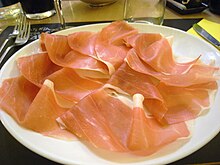Parma ham


Parma ham , Prosciutto di Parma in Italian , is an air-dried ham from the province of Parma, northwest of Bologna . It has a mild, spicy taste, is pink in color with a fine fat grain and the consistency is crumbly.
The place of origin of the Parma ham is Langhirano on the Parma river , where a large part of the ham is still produced today.
In Italy, the bone is usually left on the ham and is only cut into wafer-thin slices immediately before consumption. Classically it is served with melon wedges or other fruits as a starter .
Manufacturing
Parma ham is only made from Large White , Landrace and Duroc pigs . These pigs can only come from the central and northern Italian regions of Emilia-Romagna , Veneto , Lombardy , Piedmont , Molise , Umbria , Tuscany , Marche , Abruzzo and Latium . They must be over 9 months old when slaughtered and weigh at least 140 kg. The pigs are fed corn and barley and the whey that is left over from the production of Parmesan , which also comes from Parma.
After slaughter, the pork legs, which weigh an average of 15 kg, are rubbed with sea salt by the salt master. The sparing use of salt in comparison to other types of ham gives the Parma ham a mild taste. After salting, the Parma ham lies in the refrigerator for 100 days, which is why ham production used to start in winter. During this time, the ham absorbs salt and at the same time loses water and thus weight. Then the salt is washed off.
The ham is then hung in special maturing halls to air dry. Opposite windows in these ensure a constant flow of air. The air flowing past removes water vapor, the ham continues to dry slowly and develops its aroma. In order to prevent the meat from drying out too much, the ham is coated with a mixture of lard and salt.
After a ripening period of at least one year (some ripen up to three years), the Parma ham is tested by an independent inspector by piercing a sharp horse bone at five precisely defined points and in particular checking the smell and the consistency of the Parma ham with the bone. Hams that have passed all the quality tests are given a five-point crown.
trade
In 2014, 8.8 million units were sold. Of this, 30% was exported. The largest European export market was Germany with 444,000 units, followed by France with 436,000 units. A total of 890,000 Parma ham were exported to the European markets.
Trademark aspects
“Parma ham” is a designation of origin protected by the EU with a DOP seal . Only ham produced in the Parma region, which comes from pigs from one of the ten regions of northern and central Italy, may be offered under this name.
According to a ruling by the European Court of Justice, if it is cut and packaged, it must also be done in the Parma region. The Consorzio del Prosciutto di Parma monitors compliance with these regulations . Real Parma ham is stamped with the five-pointed crown of the Duchy of Parma on the rind and on the self-service pack.
Individual evidence
-
↑ a b c The pigs (German) , on www.prosciuttodiparma.com, accessed on November 28, 2019 (there with a typo: "Landra
nce"!) - ↑ Prosciutto di Parma press kit , (German), on prosciuttodiparma.com, accessed on November 28, 2019
- ^ The production (German) , on prosciuttodiparma.com, accessed on March 24, 2016
- ↑ The five-pointed crown , at prosciuttodiparma.com, accessed November 28, 2019
- ↑ Parma ham: Solid growth 2018 , accessed on November 28, 2019
- ↑ Largest importer of pork , ORF.at, November 29, 2014

